
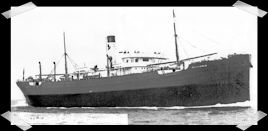 |
| The Thistlemor |
The Thistlemor was registered at the Port of Sunderland.
The ship was 350 feet long with a maximum breadth of 51 feet. Her designed speed was 9.5 knots but she achieved a speed of 12 knots on trials. The vessel was built to Lloyd's 100 A1 class.
The Thistlemor was built with a raised bridge deck extending for nearly two-thirds of her length, on which the officers and engineers were berthed. The ship’s crew were berthed in the forecastle in the bow area of the ship and also in the poop area at the stern of the ship.The forewell deck was located between the forecastle and the raised bridge deck and likewise the afterwell was located between the raised bridge deck and the poop deck. Both well decks were surrounded by solid bulwarks fitted with freeing ports to allow water to run away.
The vessel was fitted with ventilators on deck leading down to cargo spaces and engine room. Each ventilator was fitted with sockets, riveted to the decks, and cowl heads to funnel the ventilation. It has to be noted that it was owing to the ventilator shaft and socket on the forewell deck being washed away that subsequently led to the Thistlemor foundering.
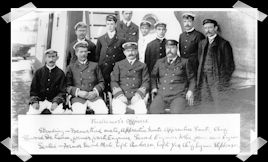 |
| The Thistlemor's Officers |
The Thistlrmor had two lifeboats one on each side of the bridge under davits. In addition there was also a dinghy and gig equipped and in good order. She had 36 lifebelts, 6 lifebuoys and a sufficient number of socket signals,rockets and blue lights.
The Thistlemor docked in Cardiff having arrived from dry-docking in Birkenhead following a thorough overhaul of her hull and machinery. Her master, a Cornish man, Captain Samuel Yeo went on leave and left the ship under the command of Captain James William Anderson who had previously been sailing as mate of the ship.
Captain Anderson was a well qualified Master holding an Extra Master’s certificate in both sail and steam. He came from North Shields on the banks of the River Tyne and had lectured at the South Shields marine school from 1904 to 1906 as a Navigation Master. He was married with five children. His two sons followed him to sea also qualifying as Master Mariners.
In Cardiff, the Thistlemor loaded 4,575 tons of coals for Capetown, South Africa. The ship was satisfactorily loaded and had a draft forward of 24ft 2inches and 23ft 8 inches aft on departure. That being 6 inches by the head but acceptable.
The Thistlemor left the Alexandra Dock, Cardiff, with Mr Richards as pilot at 9 a.m. on the 2nd December 1909.
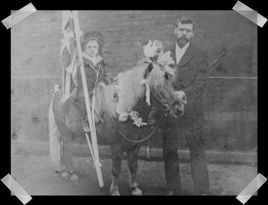 |
| Capt. James Anderson with his son |
Reading the barometer and determining through the rise or fall of the pressure readings help mariners in determining impending weather conditions as do the direction of the wind and changes in wind direction and strength.
The ship continued down the Bristol Channel making about 9 knots with the weather becoming threatening with some rain and mist and an increasing south westerly wind. During the course of the day the wind increased in strength becoming a south-westerly gale. At 11pm a very fierce west south-westerly was blowing with rain and a heavy sea running. The ship’s speed was reduced to ease the ship’s passage and avoid damage. However water made its way into the forecastle from a ventilator that had been washed away. The hole was quickly plugged and little water damage was done.
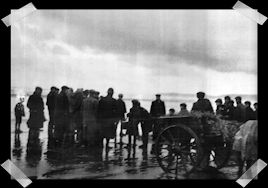 |
| Collecting the bodies on the beach |
Coal cargos are susceptible to spontaneous combustion and must be ventilated to prevent heating and fire in the cargo. It would appear that the weather conditions were not expected to worsen to the extent that they did and that the ship continued with the ventilators open and trimmed for surface ventilation as required for coal cargos. Clearing the land in the lower reaches of the Bristol channel a large swell might have developed combining with the increasing wind and seas to present the ship with a hazardous situation.
Sometime around midnight the ship was turned about, no easy task in the sea conditions with the ship going by the head and the propeller rising out of the sea. The pumps were started to pump out the water from the main cargo hold.
Captain Anderson was attempting to bring the ship back up to Lundy
Island to seek shelter and secure the hole in the deck and pump out the
flooded main cargo hold.
 |
| The funeral service |
At this time some crew were attempting to abandon ship using the port lifeboat with the intention of boarding the ss Arndale which ship was approaching the scene.
The structural strength of the ventilators just fulfilled the minimum of Lloyd’s requirements. Three ventilators were washed away from the Thistlemor during this gale. The loss of the ship was, with the consequent loss of life, due the ventilators weakness and being washed away.
At 1.30 a.m. The forward hatches blew off and by 2 a.m. The ship was unmanageable. Distress flares were fired from the
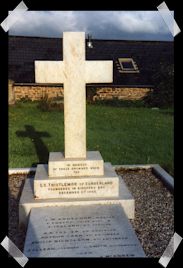 |
| The grave site |
Some the Thistlemor’s crew launched a lifeboat into the water which capsized. Fortunately, with great skill, the Arndale was able to pluck nine survivors from the seas. The wind was now hurricane force with blinding rain showers. The Arndale lost sight of the Thistlemor for a while but when the casualty was found again she had capsized and was bottom up before finally sinking in Bideford Bay.
The subsequent inquiry, as well as being critical of the ventilators, was critical of the initiative shown by the the coastguards when distress flares were first sighted at 4 a.m.
Flares were first seen at Clovelly at 6.20a.m. Only minutes before the Thistlemor sank. The lifeboat was immediately called out but arrived half an hour too late to rescue anybody.
Those tragically lost in the loss of the Thistlemor are buried in a grave at Northam church, Bideford.